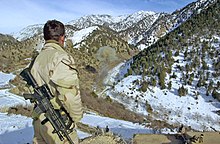2002 in Afghanistan
1st Class Nathan Ross Chapman of San Antonio, Texas, was killed in an ambush in eastern Afghanistan, the first U.S. soldier to die by hostile fire.
Sunday, January 27: U.S. Special forces backed a local Afghan militia attack which killed 6 Al-Qaeda personnel held up in a hospital in Kandahar.
Saturday, February 2: Afghan interim leader Hamid Karzai established a special committee to investigate factional violence threatening the stability of Afghanistan.
The nine-member commission, headed by Border Affairs Minister Amanullah Zadran, flew by helicopter immediately to the eastern city of Gardez where violence had erupted days before.
Tuesday, February 5: Calling on his countrymen to "take each other's hands" to rebuild the nation, interim Afghan leader Hamid Karzai raised Afghanistan's new flag over the presidential palace.
Thursday, February 7: U.S. President George W. Bush decided that the 1949 Geneva Conventions would apply to captured Taliban fighters taken from Afghanistan to a US military base at Guantánamo Bay, Cuba, but not to al-Qaeda members there.
Saturday, February 9: Hamid Karzai, head of the Afghan interim government, appointed Maulvi Zia-ul-haq Haqyar and Sayed Ikramuddin Masoomi as the new governors of Baghlan and Takhar provinces in northern Afghanistan.
Monday, February 11: Interim Afghan leader Hamid Karzai met with United Arab Emirates President His Highness Sheikh Zayed bin Sultan Al Nahyan.
The UAE announced it allocated $6 million for Afghan humanitarian relief, setting up refugee camps on the Pakistan-Afghan border near the Pakistan town of Chaman.
Wednesday, February 13: The United States Congress stepped in to find nearly $300m in humanitarian and reconstruction funds for Afghanistan after the Bush administration failed to request any money in the latest budget.
Thursday, February 14: Afghan interim leader Hamid Karzai visited Jalalabad to attend a function being held there in memory of former mujahedin commander Abdul Haq.
Tuesday, February 26: Accompanied by a strong 36-member delegation, which includes Foreign Minister Abdullah, Afghanistan interim head Hamid Karzai arrived in New Delhi, India to discuss efforts underway for rehabilitation and reconstruction.
Wednesday, February 27: Afghan interim leader Hamid Karzai attended a special ceremonial reception at the Rashtrapati Bhavan in New Delhi, India.
Saturday, March 2: In an incident of friendly fire, U.S. Army Chief Warrant Officer Stanley Harriman, of the Third Special Forces Group, and two Afghans were killed by a U.S. AC-130 gunship that mistook their convoy for enemies.
(see details of the UNHCR Afghan repatriation programs) Saturday, April 13: A U.S.-Afghan patrol comes under attack by 20 militants, air support is called in which killed five of them.
[5] Wednesday, April 17: Two U.S. pilots, Majors Harry Schmidt and William Umbach, returning from a 10-hour patrol, at more than 15,000 feet, spotted surface-to-air fire and feared it was from Taliban forces.
[12] Monday, July 1: In central Uruzgan province, a U.S. B-52 struck suspected al-Qaeda and Taliban cave and bunker complexes, while an AC-130 gunship strafed several villages.
Saturday, November 2: Tajik forces loyal to Ismail Khan, the governor of Herat Province, launched the attack in the Zer-e-Koh district, killing two civilians and injuring 15 in a crowded market.
Thursday, November 7: Afghanistan's President Hamid Karzai ordered the release of 20 female prisoners in a goodwill gesture one day after the start of the holy month of Ramadan.
After the two sides exchanged fire with light machine-guns and rocket-propelled grenades for two hours, the American helicopters attacked the gunmen's positions on cliffs surrounding Kikara village, near Khost, Afghanistan.
The 750 mile (1,200 km) route, which runs fromKabul through Kandahar and then to Herat, was built in the 1960s with U.S. funds, but devastated during the 1980s Soviet occupation and the civil war that followed.
Monday, November 11: A team of representatives of the Afghan Human Rights Commission and the U.N. was dispatched to the north to look into the reports that witnesses of mass killings were being harassed, detained, tortured and executed.
Wednesday, November 13: 2,000 students assembled outside the gates of Kabul University, refusing to attend lessons until their demands for improved accommodation and justice for those who died in recent protests were met.
Thursday, November 21: A large quantity of explosives was found by Afghan police in the generator room of the Sarobi Dam in Kabul, averting a possible sabotage attack.
Friday, November 22: A Kurdish man from Iraq, Bohtan Akram Tawfiq Horami, carrying 10 kg (22 lb) of C-4 explosive material in his coat, was arrested in Wazir Akbar Khan, an affluent neighborhood of Kabul, where many foreigners have homes and offices.
Wednesday, November 27: A New Zealand telecoms company Argent Networks won a $4.5 million contract to develop cellular and internet services in Afghanistan.
Saturday, November 30: In Moscow, Afghan foreign minister, Abdullah, and his Russian counterpart, Igor Ivanov, held talks focusing on security issues.
[30] Thursday, December 12: The Afghan Cable Center in Jalalabad, which had been broadcasting more than 20 foreign television channels, was closed down by a special decision of the Afghanistan Supreme Court presided over by chief justice Mowlawi Fazl Hadi Shinwari.
Friday, December 27: In the Gardez District of Afghanistan, five people were killed and six wounded when guests at a wedding party fired a rocket propelled grenade into the air, only to have it land nearby and explode.
The soldier was evacuated to the U.S. military's medical center in Landstuhl, Germany, then transferred to a nearby German hospital for more specific neurological treatment, and a week later flown home to the United States.




